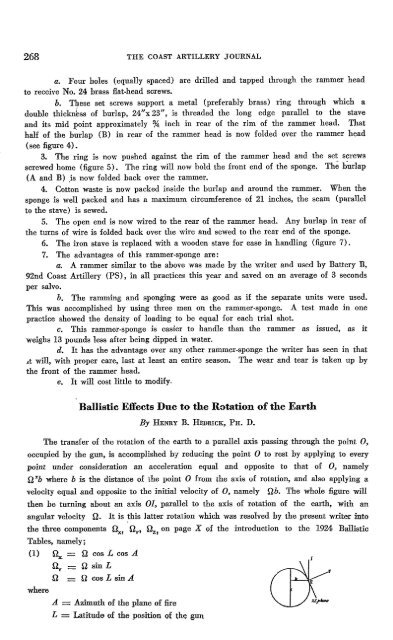THE COAST ARTILLERY JOURNAL - Air Defense Artillery
THE COAST ARTILLERY JOURNAL - Air Defense Artillery
THE COAST ARTILLERY JOURNAL - Air Defense Artillery
You also want an ePaper? Increase the reach of your titles
YUMPU automatically turns print PDFs into web optimized ePapers that Google loves.
268 <strong>THE</strong> <strong>COAST</strong> <strong>ARTILLERY</strong> <strong>JOURNAL</strong><br />
a. Four holes (equally spaced) are drilled and tapped through the rammer head<br />
to receive No. 24 brass flat-head screws.<br />
b. These set screws support a metal (preferably brass) ring through which a<br />
double thicknkss of burlap, 24"x 23", is threaded the long edge parallel to the stave<br />
and its mid point approximately % inch in rear of the rim of the rammer head. That<br />
half of the b~rlap (B) in rear of the rammer head is now folded over the rammer head<br />
(see figure 4).<br />
3. The ring is now pushed against the rim of the rammer head and the set screws<br />
screwed home (figure 5). The ring will now hold the front end of the sponge. The burlap<br />
(A and B) .is now folded back over the rammer.<br />
4. Cotton waste is now packed inside the burlap and around the rammer. When the<br />
sponge is well packed and has a maximum circumference of 21 inches, the seam (parallel<br />
to the stave) is sewed.<br />
5. The open end is now wired to the rear of the rammer head. Any burlap in rear of<br />
the turns of wire is folded back over the wire and sewed to the rear end of the sponge.<br />
6. The iron stave is replaced with a wooden stave for ease in handling (figure 7).<br />
7. The advantages of this rammer-sponge are:<br />
a. A rammer similar to the above was made by the writer and used by Battery B,<br />
92nd Coast <strong>Artillery</strong> (PS), in all practices this year and saved on an average of 3 seconds<br />
per salvo.<br />
b. The ramming and sponging were as good as if the separate units were used.<br />
This was accomplished by using three men on the rammer-sponge. A test made in one<br />
practice showed the density of loading to be equal for each trial shot.<br />
c. This rammer-sponge is easier to handle than the rammer as issued, as it<br />
weighs 13 pounds less after being dipped in water.<br />
d. It has the advantage over any other rammer-sponge the writer has seen in that<br />
.t will, with proper care, last at least an entire season. The wear and tear is taken up by<br />
the front of the rammer head.<br />
e. It will cost little to modify-<br />
Ballistic Effects Due to the Rotation of the Earth<br />
By HENRY B. HEDRICK, PH. D.<br />
The transfer of the rotation of the earth to a parallel axis passing through the point 0,<br />
occupied by the gun, is accomplished by reducing the point 0 to rest by applying to every<br />
point under consideration an acceleration equal and opposite to that of 0, namely<br />
ll'b where b is the distance of the point 0 from the axis of rotation, and also applying a<br />
velocity equal and opposite to the initial velocity of 0, namely Qb. The whole figure will<br />
then be turning about an axis 01, parallel to the axis of rotation of the earth, with an<br />
angular velocity ll. It is ~his latter rotation which was resolved by the present writer into<br />
the three components llx. lly, llz, on page X of the introduction to the 1924 Ballistic<br />
Tables, namely;<br />
(1) n,,, Q cos L cos A<br />
where<br />
~_llsinL<br />
II _ Q cosLsinA<br />
A = Azimuth of the plane of fire<br />
L = Latitude of the position of the gUn
















